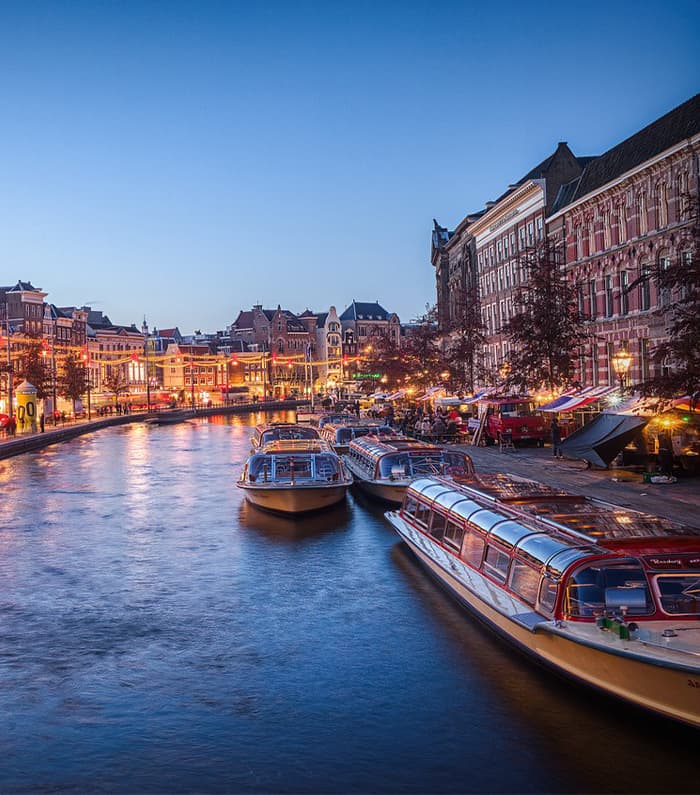A boat trip on the canals of Amsterdam

Walks on the canals of Amsterdam ─ the most popular entertainment for tourists. Every year millions of vacationers take part in excursions on river streetcars, boats with a glass dome, special water cab. The total length of the canals of the Dutch capital is impressive ─ 100 km, but they are not used for navigation. High waves erode the shore, so the speed limit allows to move here only pleasure boats.
In Amsterdam there are 165 canals and 1500 bridges, which have recently celebrated their 400th anniversary. The scheme of canals looks like concentric semicircles with radial canals ─ something like half a bicycle wheel with spokes. Fresh water is obtained by canals “Northern Venice” with the help of locks. Tours are offered here in many languages.
Do not forget that we have a special audio guide to Amsterdam in Russian, which will help you get to know Amsterdam even better.
Amsterdam Canal Tours
Single canal tour tickets start at €10. Audioguides are available (including in Russian). In the city center you can choose a boat:
- At Central Station.
- At the piers of Damrak and Rokin streets.
- At the pier at the State Museum.
The tour lasts 1 hour, you will see the main attractions of the city and listen about them in Russian. Book your tickets at this link.
If there is enough time you can choose another variant of walk with buying of hop-on-hop-off boat (look here). These boats have several routes with stops at museums, stores and attractions. You get off at any stop and then continue your journey with the same ticket, as there is no limit on the number of trips. A very convenient option for those who are only in Amsterdam for a couple of days and want to see a lot of things.
Another option is dinner on the boat. Soups, cheeses, desserts, traditional Dutch cuisine – everything is on the menu, and the walls of the restaurant are Amsterdam itself. Enjoy not only a stroll through the city, but also good food, make your reservations at this link.
View different canal walk options here.
The canals of Amsterdam ─ symbol of the country
In the 15th and 16th centuries the capital was threatened by overcrowding, so they decided to expand the city’s borders by digging the Singel canal ─ the first canal encircling the city. Along the banks merchants built houses, wharves and shipyards to repair ships. On the road from Amsterdam to Haarlem they built a new ditch Brouwers-gracht ─ the brewery canal. The first phase of the Grand Canals (northern part) appeared in the XVII century.
The northern canals
In 1609 an ordinary carpenter, Hendrik Staats, came up with an idea by which the building area could be tripled. If three parallel canals were dug around Amsterdam, the selected soil could be used to build embankments for buildings, warehouses, and piers. For half a century the capital became a solid construction site. Construction moved southward and by the end of construction the city was hard to recognize with the construction of three canals:
- Herengrach – Gospod.
- Keizersgracht – Imperial.
- Prinsengracht – the Princes’ Canal.
Along the grid of canals there were rich houses, beautifully preserved to this day. In addition to the lavish decoration of gables and doorways, each house has its own history.
South Canals
The southern loop of canals stretches from Roudhuisstraat to Amstel. They were constructed in two phases: the first part ─ up to Leidsestraat, and in 1660, southwest of Amstel, work continued on the second section of the garland. The plots were only available to the rich, so the mansions were erected spacious and luxurious. The area was named Gouden Bocht ─ The Golden Bend
In the 19th century, the silence of the neighbourhood was broken by the construction of new communications stretching from the center to the Museum Quarter and Vondelpark. This is the most modern area with antique stores, theaters, museums, temples and the University, hotels and brothels. The nightlife of the city, when the waterways are illuminated by thousands of orange lights, can be seen on Rembrandtplein and Leidseplein squares.
As one approaches the Amstel, one notices the changing character of the canals. Beautiful bridges, residential floating houses and beautiful views appear.
Residential boats in Amsterdam
Many citizens after World War II did not have enough housing, so they settled in boats and barges near the banks of canals. Today there are about 2,500 such floating houses ─ wooden, iron, concrete woonboot ─ about 2,500 boats. You can distinguish legal, registered floating accommodation from illegal by the presence of communications and fixed place. There are residential boats converted from the cargo ship. Despite the superstructure, vintage ships look charming.
Of the more modern options for building floating houses can be noted debarker, on which the wooden house is erected. Such a boat is unlikely to sail away because of the neighboring bridges. The cost of living in such boats is not cheaper than in conventional houses, because they require periodic repairs at the docks, plus annual insurance, property tax, charges for electricity, water, sewerage, telephone and cable TV.
One of these unusual homes is well worth staying in.
Cruise along the canals and the historic center of the city ─ tourist debt of visitors to the Dutch metropolis. In 2010, the canals of Amsterdam were included in the list of World Heritage Sites by UNESCO. Together with the mills, wooden clogs and tulips, they have become a trademark of the city, giving it charm and uniqueness. So don’t miss your chance to take a ride.